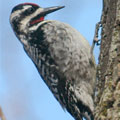An ally
 Yellow-bellied sapsuckers Sphyrapicus varius variusCredit: Serge Beaudette(Size: 25.15 kb) |
Hummingbirds feed on insects and nectar. As they await the blossoming of the first flowers of spring, Ruby-throated Hummingbirds sometimes feed on the sap that runs from trees, through holes pecked by Yellow-bellied Sapsuckers. Sap is as rich in sucrose as nectar is. It is thus an excellent substitute for nectar. As well, sap captures the insects that have just entered the holes.
Getting there just the same
 Ruby-throated Hummingbird Archilochus colubrisCredit: Cobalt123(Size: 202.61 kb) |
Certain mites that feed on nectar and pollen take advantage of the presence of hummingbirds to move to another flower. When a hummingbird stops at a flower, mites hang onto its beak and make their way into its nasal cavities, where they remain until the hummingbird visits another flower. These mites do not affect the hummingbird in any way; they complete their reproductive cycle in flowers. The development of a mite from the egg to the adult stage takes between 4 and 7 days. When a hummingbird goes by, mites hitch a ride to switch flowers and begin the reproductive cycle again.
A myth
 Canada Goose Branta canadensisCredit: Jeff(Size: 203.89 kb) |
Certain species of hummingbird travel very long distances to get to their winter homes. In the past, it was hard for people to believe that such tiny birds, seeming so fragile, could travel for thousands of kilometres. They were said to travel on the backs of larger birds, like Canada Geese.
Territorial
It is very rare to see two adult hummingbirds spend a lot of time together. When more than one hummingbird is seen at the same time, aggressive behaviour is usually involved. Each is laying claim to a source of food that it's trying to protect.
And humans
 Ruby-throated Hummingbirds Archilochus colubrisCredit: Sam Alfano(Size: 49.75 kb) |
Humans have learned to make a sweet syrup that hummingbirds adore. Hummingbirds are not dependent on humans, but if you move a feeder, they will be quick to notice it. Hummingbirds also perform a service for humans, pollinating lots of plants whose fruit is eaten by humans. The process begins when a hummingbird draws nectar from the bottom of the corolla of flowers. Pollen sticks to its feathers. If the hummingbird flies off to another flower of the same species, the pollen left behind pollinates the flower. The word for hummingbird in Spanish is picaflor, which means "flower pecker," and in Portugese, bija flor, meaning "flower kisser."
- For the recipe for nectar, follow this link.
- To discover a legend featuring hummingbirds and other species, follow this link.
|

